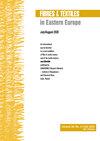针织发热垫
IF 0.9
4区 工程技术
Q3 MATERIALS SCIENCE, TEXTILES
引用次数: 0
摘要
摘要 本文论述了柔性针织加热垫的概念设计和研究,其结构不同于低弹性编织物或无纺布箔基材上的纺织加热器。利用针织技术设计和制造了两种弹性为相对伸长率 100% 至 300% 的加热垫。加热垫的加热元件是平行连接的一组导电碳线和涂有银的合成线。在伸长率为 210% 至 270% 的相当大的范围内,没有观察到加热元件损坏,拉伸过程中的电阻变化相当于 0.015 至 0.22 Ω/%的伸长率。由于导电线(电阻器)密度适当,针织物结构合理,因此在 12 V 电源电压下,针织加热器的最佳功率为 16 至 41 W,热效率高。加热器的表面温度可在 34 ℃ 至 43 ℃ 之间调节,符合人体的热舒适度。针织加热器的一种变体被用于制造办公椅的座椅和靠背。本文章由计算机程序翻译,如有差异,请以英文原文为准。
Knitted Heating Mats
Abstract The paper deals with conceptual designs and research on flexible knitted heating mats differing in construction from textile heaters on low-elastic woven or nonwoven-foil substrates. Two variants of heating mats with elasticity from 100 to 300 % of relative elongation were designed and manufactured using knitting technology. The heating elements of the mats were parallel-connected sets of electrically conducted carbon threads and synthetic threads coated with silver. With considerable elongation in the range of 210÷270 % no damage was observed to the heating elements and resistance changes during the stretching process equaled from 0.015 to 0.22 Ω/% of elongation. The optimum power of the knitted heater in the range from 16 to 41 W, with high thermal efficiency for a 12 V supply voltage, was obtained thanks to proper density of the electrically conductive threads (resistors) and the appropriate structure of the knitted fabric. The surface temperature of the heater can be adjusted from 34 to 43 °C, which corresponds to human thermal comfort. One of the variants of the knitted heaters was applied in the construction of the seat and backrest of an office chair.
求助全文
通过发布文献求助,成功后即可免费获取论文全文。
去求助
来源期刊

Fibres & Textiles in Eastern Europe
工程技术-材料科学:纺织
CiteScore
1.60
自引率
11.10%
发文量
12
审稿时长
13.5 months
期刊介绍:
FIBRES & TEXTILES in Eastern Europe is a peer reviewed bimonthly scientific journal devoted to current problems of fibre, textile and fibrous products’ science as well as general economic problems of textile industry worldwide. The content of the journal is available online as free open access.
FIBRES & TEXTILES in Eastern Europe constitutes a forum for the exchange of information and the establishment of mutual contact for cooperation between scientific centres, as well as between science and industry.
 求助内容:
求助内容: 应助结果提醒方式:
应助结果提醒方式:


